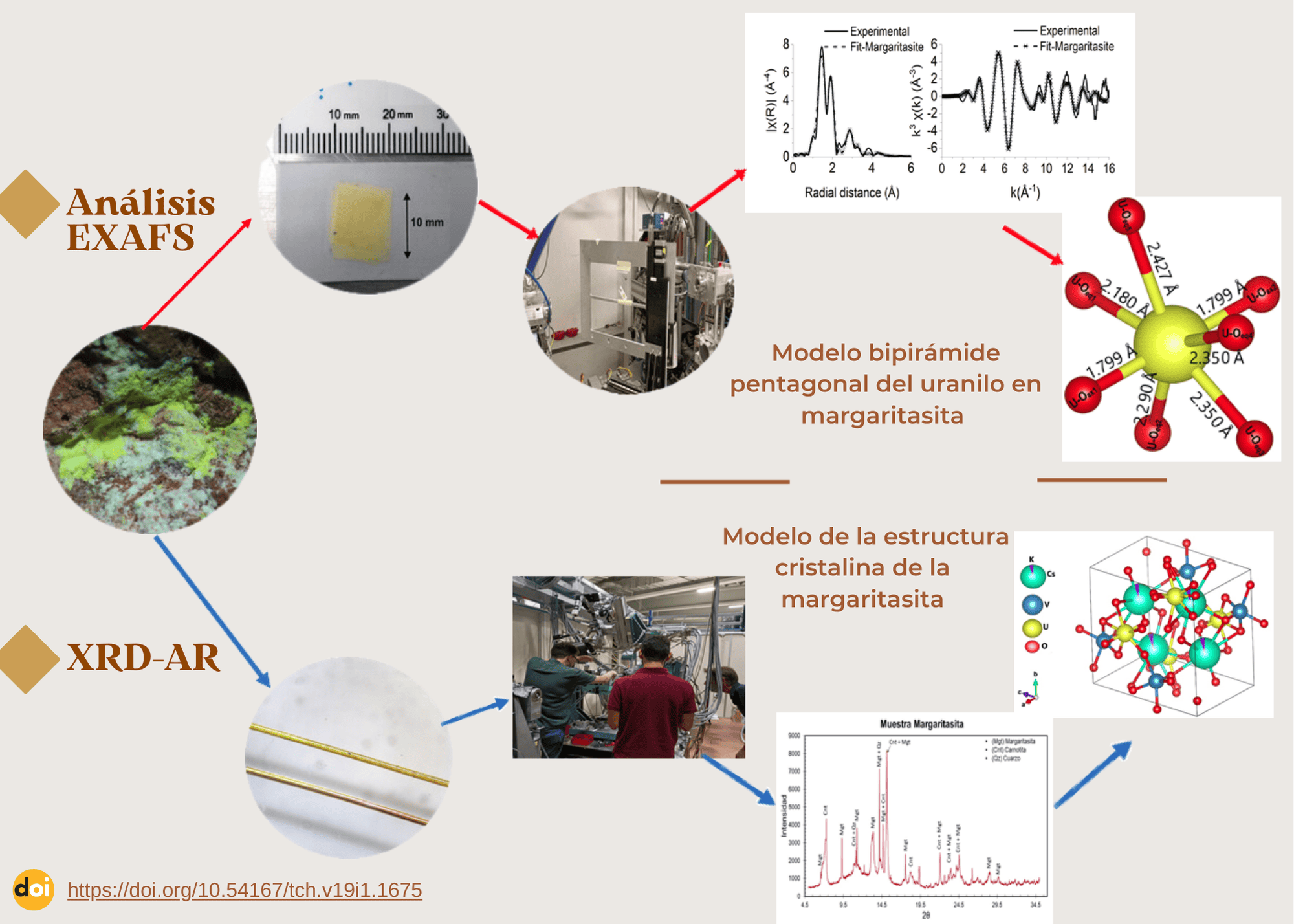Margaritasita: Un mineral exclusivamente Chihuahuense
DOI:
https://doi.org/10.54167/tch.v19i1.1675Palabras clave:
Margaritasita, Chihuahua, sincrotrón, EXAFSResumen
La margaritasita [Cs2(UO2)2(VO4)2·nH2O] es un uranovanadato descrito hasta el día de hoy únicamente en la Sierra Peña Blanca, Chihuahua. En este trabajo se comparten los resultados obtenidos de la caracterización de margaritasita, empleando las técnicas de difracción de rayos X de alta resolución (DRX-AR) y espectroscopía de estructura fina por la absorción de rayos X (EXAFS), las cuales utilizan luz sincrotrón. Para este trabajo se realizó la caracterización en el sincrotrón de Diamond Light Source estación B18 (en Reino Unido) y en el difractómetro de alta precisión de Elettra en Triestre (Italia).
La margaritasita, con hábito tabular micrométrico entre 1 y 3 μm, presenta las fases margaritasita pura y carnotita en solución sólida desordenada con una relación de potasio (K) y cesio (Cs) de 1:1, acompañadas de cuarzo, montmorillonita, feldespato potásico y calcita. Mediante estructura de los rayos X cerca del borde de absorción (por sus siglas en inglés XANES) y EXAFS se comprobó la asociación de vanadio y cesio con uranio en la fase margaritasita. En el estudio se caracterizó la estructura del prisma pentagonal uranilo determinando las distancias de unión entre el uranio y el oxígeno U-O, característica de los uranovanadatos.
DOI: https://doi.org/10.54167/tch.v19i1.1675
Descargas
Citas
Alba, L.A., & Chávez, R. (1974). K-Ar ages of volcanics rocks from the central Sierra Peña Blanca, Chihuahua, México. Isochron/West, Bulletin of Isotopic Geochronology 10: 21–23. https://geoinfo.nmt.edu/publications/periodicals/isochronwest/home.cfml?Issue=10
Appleman, D.E., Evans, J., & Howard, T. (1965). The crystal structures of synthetic anhydrous carnotite, K2(UO2)2V2O8, and its cesium analogue, Cs2(UO2)2V2O8. Am. Mineral., 50: 825–843. https://rruff.geo.arizona.edu/AMS/result.php?key=_database_code_amcsd+0000135&viewing=html
Faudoa, F., Fuentes, L., Esparza, H., Canche, J., Reyes, I., Fuentes, M., Eichert, D., Rodríguez, Y., & Montero, M. (2024). Geological and Crystallochemical Characterization of the Margaritasite–Carnotite Mineral from the Uranium Region of Peña Blanca, Chihuahua, Mexico. Minerals, 14(4): 431. https://doi.org/10.3390/min14040431
Goodell, P., Trentham, R., & Carroway, K. (1978). Geologic Setting of the Pena Blanca Uranium Deposits. In Formation of Uranium Ores by Diagenesis of Volcanic Sediments: Grand Junction, US Dept. of Energy Report GJBX. In: Henry, C.D., Walton, A.W. (Eds.), Formation of Uranium Ores by Diagenesis of Volcanic Sediments. US Bureau of Economic Geology: The University of Texas at Austin, TX, USA; pp. 22–79. https://hdl.handle.net/2152/123912
Goodell, P.C. (1985). Chihuahua City Uranium Province, Chihuahua Mex. In Proceedings of the Technical Committee Meeting on Uranium Deposits in Volcanic Rocks, El Paso, TX, USA, 2–5 April 1984; IAEA: El Paso, TX, USA; pp. 97–124. https://inis.iaea.org/records/z73ve-sqe42
Instituto Nacional de Investigaciones Nucleares (ININ), (2023). https://goo.su/PqnVzm
Keith, T.E.C., Thompson, J.M., & Mays, R.E.(1983). Selective concentration of cesium in analcime during hydrothermal alteration, Yellowstone National Park, Wyoming. Geochim. et Cosmochim. Acta, 47(4): 795–804. https://doi.org/10.1016/0016-7037(83)90113-8
Newville, M. (2014). Fundamentals of XAFS. Reviews in Mineralogy and Geochemistry 78 (1): 33–74. https://doi.org/10.2138/rmg.2014.78.2
Parson, T. (2006). Chapter 7 The basin and Range province. In: Osen, K.H. (Ed.) Developments in Geotectonics, Elsevier, Vol. 25, pp. 277-XV. https://doi.org/10.1016/S0419-0254(06)80015-7
Ravel, B., & Newville, M. (2005). ATHENA, ARTEMIS, HEPHAESTUS: Data analysis for X-ray absorption spectroscopy using IFEFFIT. J. Synchrotron Radiat. 12: 537–541. https://doi.org/10.1107/S0909049505012719
Rehr, J.J.; Albers, R.C. (2000) Theoretical approaches to X-ray absorption fine structure. Rev. Mod. Phys., 72: 621. https://doi.org/10.1103/RevModPhys.72.621
Rodríguez-Carvajal, J. (1993). Recent advances in magnetic structure determination by neutron powder diffraction. Phys. B: Condens. Matter, 192(1-2): 55–69. https://doi.org/10.1016/0921-4526(93)90108-I
Salas, G.P., & Nieto, F.C. (1991). Geology of uranium deposits in Mexico. In Economic Geology, Mexico; Geological Society of America: Boulder, CO, USA; Volume P-3, pp. 161–166. https://goo.su/ds7HL4c
Shanks, W.C.P., Morgan, L., Balistrieri, L.S., & Alt, J.C. (2005). Hydrothermal vent fluids, siliceous hydrothermal deposits, and hydrothermally altered sediments in Yellowstone Lake. In: Proceedings of the Thermal Biology Institute Workshop, Yellowstone National Park, WY, USA; pp. 53–72. USGS Publications Warehouse. https://pubs.usgs.gov/publication/70203380
Walker, G.W. (1981). Uranium, Thorium, and Other Metal Associations in Silicic Volcanic Complexes of the Northern Basin and Range, a Preliminary Report. US Geological Survey: Denver, CO, USA. USGS Numbered Series 2331-1258. https://doi.org/10.3133/ofr811290
Wenrich, K.J., Modreski, P.J., Zielinski, R.A.Z., & Seeley, J.L. (1982). Margaritasite: A new mineral of hydrothermal origin from the Pena Blanca Uranium District, Mexico. Am. Mineral., 67, 1273–1289. https://pubs.usgs.gov/publication/70011893

Publicado
Cómo citar
-
Resumen95
-
PDF42
-
HTML3
Número
Sección
Licencia
Derechos de autor 2025 TECNOCIENCIA Chihuahua

Esta obra está bajo una licencia internacional Creative Commons Atribución-NoComercial 4.0.
















